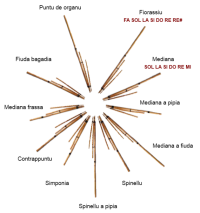LAUNEDDAS |
||||||||
|
An ancient musical instrument
If we leave aside these archaisms which the launeddas shares with many other popular wind instruments, it may be seen to stand out among all primitive clarinets by virtue of the features:
Tuning by means of the wax on the tongues of the mouthpieces, and the playing technique are common on both double pipes and bagpipes. However, I have not been able to find any other instances of the peculiar method for tuning the arrefinu, and we must conclude that the launeddas has no close relatives among recent folkmusic instruments. The other distinguishing feature of the launeddas, its triple aspect, is even more puzzling. It can be observed on a bronze figurine from Sardinia portraying a man playing a wind instrument and holding two pipes in his left hand and one in his right, just as the launeddas players do today [(Plate VIIa)]. Unfortunately the figurine was not unearthed during a scientific excavation and consequently more precise dating is not possible; nevertheless, according to the cautious estimates of Professor Giovanni Lilliu, we can ascribe it, together with the other famous Sardinian figurines, to about 900-300 B.C. There are not other representations from antiquity of triple wind instruments, and nothing can be said as to whence and when the ancestor of the launeddas came to Sardinia. From the Middle Ages we possess a representation of a triple pipe in the Spanish 13th-century manuscript of Alfonso the Wise, Cantigas de Santa Maria (Plate VIIb). This instrument, however, appears to me to consist of a double drone and a single chanter played with both hands, while the launeddas consists of one drone and two chanters. For the rest of Europe we only have the indirect evidence that the bagpipe, which appears to have gained in popularity rather suddenly in the 13th century, seems to have developed in many places by the appliance of a bag on directly blown pipes, some of witch may well have been similar to the launeddas or the triple pipe figured in the Cantigas. The early history of the launeddas is thus still completely in the dark, the material leaving us free to form two hypotheses:
However this may be, it can be stated that the launeddas has an unbroken history on Sardinian soil for 2500 years, surviving from from the tribal culture of the Bronze-age by adapting itself to the ever changing conditions of a society in evolution, and ending up as we find it today, an integral part of a 20th-century peasant community. The text reproduced on this web page is extracted from "Launeddas - A.F.W.Bentzon" |
|||||||
|
|
|
Copyright
© 2002 / 2019 Associazione Iscandula - Via Perda Bona, 6 - 09045
Quartu Sant'Elena (CA) P.IVA 01878590924 - Cell phone +39 348 2256594 - siscandula@tiscali.it |



